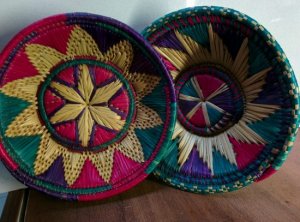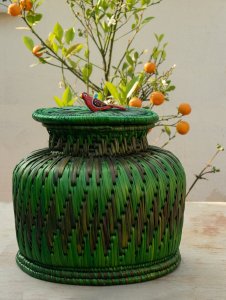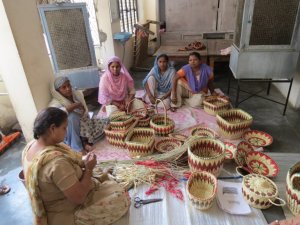Uttar Pradesh is a mixture of different cultures. Its roots are in dance, music, fine art forms, drama, and cinema. There are many craft forms that are performed in different states of Uttar Pradesh. One of them is a famous art form named as Bhadohi Grass Weaving. Bhadohi is a city in Uttar Pradesh. It is famous for its carpet all over the world. It is known as the largest home of the hand-knotted carpet weaving industry.
List of Bhadohi Grass Weaving
- What is Basket weaving?
- Bhadohi Woven Basket
- The social aspect of making baskets
- How the baskets have been created?
What is Basket weaving?
Basketry is as old a craft as perhaps pottery, practiced by communities across the world using a variety of techniques and an array of materials. Basketry is made from materials like thread, pine straw, oak, willow, wisteria, stems, animal hair, vines, grasses, and fine wooden splints. It provides a great employment opportunity. Skillful artisans involved in the making of baskets are called basket makers or basket weavers.
Different communities across the world practice the art of basket weaving, employing a host of raw materials and miscellaneous techniques. These baskets are used for religious ceremonies besides, being used for the marketing to produce from farms.
The basket is woven into lovely patterns with the use of vivid colors. You may spot these baskets across an array of homes in India for storing chapatis, flour, and various grains. What makes it useful is its notable air-tight storage especially the ones with the ‘Bhadohi’ weave. Uttar Pradesh, Punjab, Kashmir, West Bengal, Tamil Nadu, Bihar, Karnataka, and the North-East states are regions where this beautiful craft is mostly practiced.
Bhadohi Woven Basket –
Bhadohi, Allahabad, Gorakhpur, and Behraich in Uttar Pradesh are the areas where baskets are made out of Moonj (a monsoon grass). This grass is harvested in winters. It is used for the purpose of basket weaving once it is completely dried out. Moreover, the grass becomes lighter in color making it easy to take on other colors as well.
Skilled craftsmen use elementary tools and basic techniques to create exquisite work of ‘Moonj’ crafts. This ‘Moonj’ is harvested in the winter months and then it is left out for a few days for drying. The dried grass has a much lighter color too, which makes it easier for it to take on other colors for the end-product.
Using basic hand techniques and very elementary tools, stunningly beautiful ‘Moonj’ crafts are created mostly by the womenfolk. Tradition calls for the mother to pass this skill and associated techniques to her daughter.
The social aspect of making baskets –
Women’s in their homes simply weave basket with lots of chatting and with one cup of tea and they prepare more than 100 pieces of basket each day. They bought over a couple of pieces to show how the ‘neatness quotient’ was better in the ones they also compare with there in-laws. There is good competition between each and everyone, I say!
How the baskets have been created?
Let’s have a look at how the grass is turned into the most beautiful object for the home.
- a) They picked dried grass first.
- b) Then they choose a color (a raw color). Worth noting that red and green appear to be the most popular colors.
- c) Then they boil water at a high temperature in a container (typically large aluminum vessels are used) and then the raw color is added.
- d) Then the dried grass is now colored in the above mixture.
- e) The colored grass is then dried in the shade (away from the sun!)
- f) Then the outer layer of the grass which is peeled and knotted, that is made into small knots referred to as ‘Balla‘. In fact, I believe that in some places the craft itself is referred to as ‘Balla’.
- g) The motifs in the product are created by adding colored grass in between (cleverly woven).
- h) The next step is Coiling but before this can be done, the ‘Balla’ has to be made flexible and this is achieved by soaking it in cold water for hours.
- i) Then the coil is then used to make the base of the basket, after which the sides of the basket are made, using exactly the same technique.
- j) All the coils are then neatly stitched together and if the handles (if at all used) are stitched with grass!





